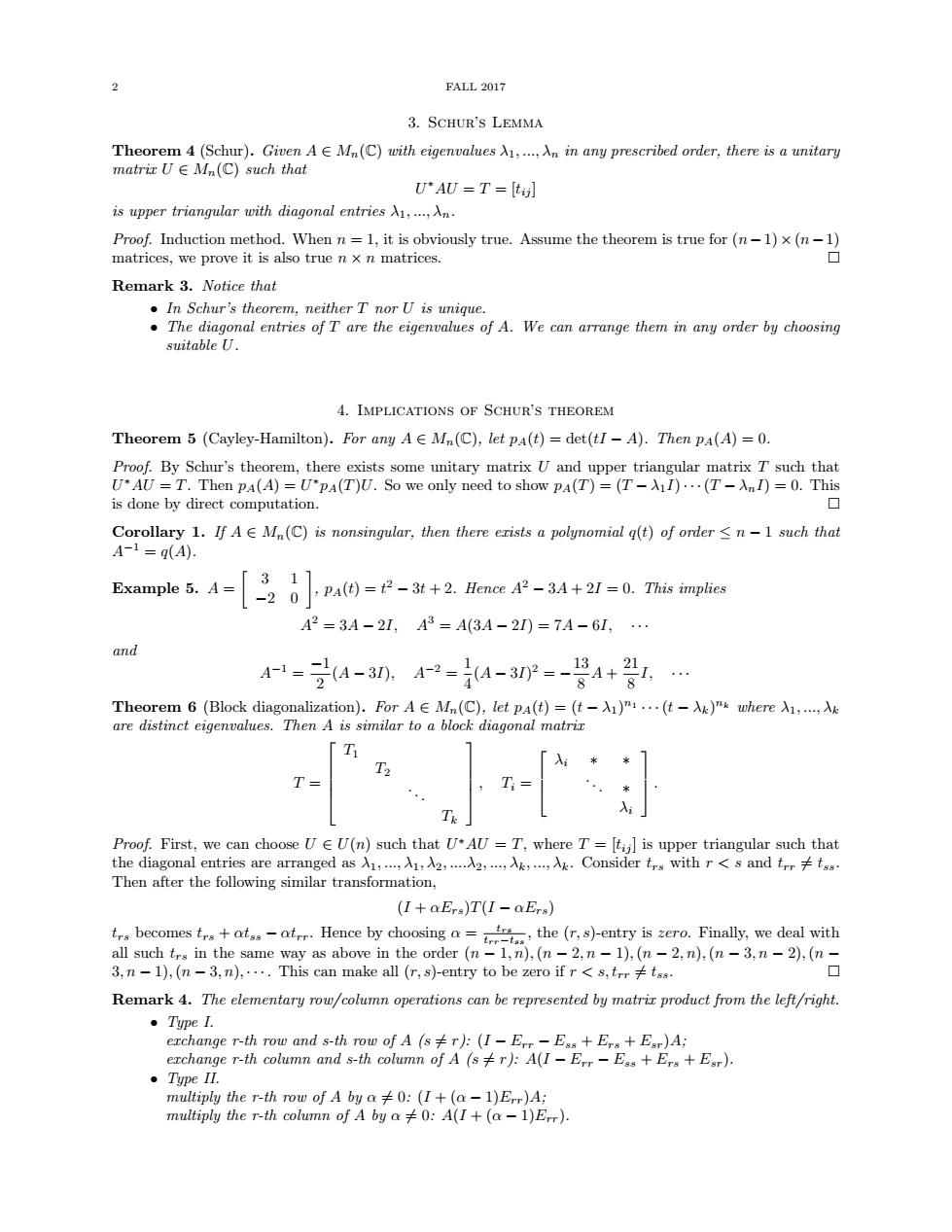正在加载图片...

2 FALL 2017 3.SCHUR'S LEMMA ).C),tere r U'AU=T=tul is upper triangular with diagonal entries. Proof.Induction method.When n=1,it is obviously true.Assume the theorem is true for (n-1)x(n-1) matrices,we prove it is also true n x n matrices. Remark 3.Notice that of A.We can arrange them in any order by choosing 4.IMPLICATIONS OF SCHUR'S THEOREM Theorem 5 (Cayley-Hamilton).For any A Mn(C),let pa(t)=det(tI-A).Then pA(A)=0. is done by dire A( Corollary 1.If AE M(C)is nonsingular,then there erists a polynomial q(t)of order <n-1 such that A-1=g(A). A2=34-21,43=A(34-2)=7A-61,… and A1-24-30,42-4-3P=-A+1 … -Ar…-Arr如 「 T= T= T Proof.First,we can choose UE U(n)such that UAU=T,where T=j]is upper triangular such that ,2...Consider tra with r<s and (I+aE)T(I-aE) all such t in the same way as above in the order (n (n2n1n2.).(nn2).(n t..becomes t. .+at..-at...Hence by choosing 3,n-1),(n -3,n),....This can make all (r,s)-entry to be zero if r<s,trt. Remark 4.The elementary ro/column operations can be represented by matrir product from the left/right. multiply the r-th row o时Aba卡0:(I+(a-1)Er)A multiply the r-th column of A by 0:A(I+(a-1)Err).2 FALL 2017 3. Schur’s Lemma Theorem 4 (Schur). Given A ∈ Mn(C) with eigenvalues λ1, ..., λn in any prescribed order, there is a unitary matrix U ∈ Mn(C) such that U ∗AU = T = [tij ] is upper triangular with diagonal entries λ1, ..., λn. Proof. Induction method. When n = 1, it is obviously true. Assume the theorem is true for (n−1)×(n−1) matrices, we prove it is also true n × n matrices. Remark 3. Notice that • In Schur’s theorem, neither T nor U is unique. • The diagonal entries of T are the eigenvalues of A. We can arrange them in any order by choosing suitable U. 4. Implications of Schur’s theorem Theorem 5 (Cayley-Hamilton). For any A ∈ Mn(C), let pA(t) = det(tI − A). Then pA(A) = 0. Proof. By Schur’s theorem, there exists some unitary matrix U and upper triangular matrix T such that U ∗AU = T. Then pA(A) = U ∗pA(T)U. So we only need to show pA(T) = (T − λ1I)· · ·(T − λnI) = 0. This is done by direct computation. Corollary 1. If A ∈ Mn(C) is nonsingular, then there exists a polynomial q(t) of order ≤ n − 1 such that A−1 = q(A). Example 5. A = 3 1 −2 0 , pA(t) = t 2 − 3t + 2. Hence A2 − 3A + 2I = 0. This implies A 2 = 3A − 2I, A3 = A(3A − 2I) = 7A − 6I, · · · and A −1 = −1 2 (A − 3I), A−2 = 1 4 (A − 3I) 2 = − 13 8 A + 21 8 I, · · · Theorem 6 (Block diagonalization). For A ∈ Mn(C), let pA(t) = (t − λ1) n1 · · ·(t − λk) nk where λ1, ..., λk are distinct eigenvalues. Then A is similar to a block diagonal matrix T = T1 T2 . . . Tk , Ti = λi ∗ ∗ . . . ∗ λi . Proof. First, we can choose U ∈ U(n) such that U ∗AU = T, where T = [tij ] is upper triangular such that the diagonal entries are arranged as λ1, ..., λ1, λ2, ....λ2, ..., λk, ..., λk. Consider trs with r < s and trr 6= tss. Then after the following similar transformation, (I + αErs)T(I − αErs) trs becomes trs + αtss − αtrr. Hence by choosing α = trs trr−tss , the (r, s)-entry is zero. Finally, we deal with all such trs in the same way as above in the order (n − 1, n),(n − 2, n − 1),(n − 2, n),(n − 3, n − 2),(n − 3, n − 1),(n − 3, n), · · · . This can make all (r, s)-entry to be zero if r < s, trr 6= tss. Remark 4. The elementary row/column operations can be represented by matrix product from the left/right. • Type I. exchange r-th row and s-th row of A (s 6= r): (I − Err − Ess + Ers + Esr)A; exchange r-th column and s-th column of A (s 6= r): A(I − Err − Ess + Ers + Esr). • Type II. multiply the r-th row of A by α 6= 0: (I + (α − 1)Err)A; multiply the r-th column of A by α 6= 0: A(I + (α − 1)Err).���